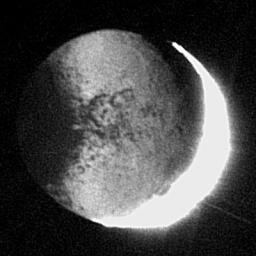It looks like you're using an Ad Blocker.
Please white-list or disable AboveTopSecret.com in your ad-blocking tool.
Thank you.
Some features of ATS will be disabled while you continue to use an ad-blocker.
share:
The impact that ripped the moon from the earth was rather large, most likely so large there would not be a crater so to speak.
reply to post by skuly
Perhaps there may be some truth in the story of Lemur and Atlantis, according to that story the Lemurians, who were initially on Mars, have settled and merged their race with that of the Atlantis on Earth. They moved from their homeland, Mars after a terrible destruction. Perhaps Mars was like the Earth and had all that, I've seen lots of evidence that points to the likelihood of Mars being like the Earth, though no traces of plant or bacterial life so far, yet traces of water....
It must have been millions or billions of years ago who knows - enough time to leave barely any traces that there has ever been life there and that the planet has been settled.
Speaking of the moons, Iapetus looks a lot like Mimas, the same 'death-star' look.
Also, I think Enceladus is a very interesting Moon.
Perhaps there may be some truth in the story of Lemur and Atlantis, according to that story the Lemurians, who were initially on Mars, have settled and merged their race with that of the Atlantis on Earth. They moved from their homeland, Mars after a terrible destruction. Perhaps Mars was like the Earth and had all that, I've seen lots of evidence that points to the likelihood of Mars being like the Earth, though no traces of plant or bacterial life so far, yet traces of water....
It must have been millions or billions of years ago who knows - enough time to leave barely any traces that there has ever been life there and that the planet has been settled.
Speaking of the moons, Iapetus looks a lot like Mimas, the same 'death-star' look.
Also, I think Enceladus is a very interesting Moon.
reply to post by eriktheawful
Haven't got much to add to the thread, I just wanted to say I really enjoyed reading it.
Well done
ALS
Haven't got much to add to the thread, I just wanted to say I really enjoyed reading it.
Well done
ALS
Xtrozero
The impact that ripped the moon from the earth was rather large, most likely so large there would not be a crater so to speak.
That's true, and with good reason.
The widely accepted Giant Impact Hypothesis has a Mars sized object striking the Earth 4.5 billion years ago.
The amount of energy involved in such a massive impact would have turned the entire Earth molten again. By the time the Earth cooled back down, all traces of such an impact would be gone.
In order to leave traces, very large impacts can not be so large the the energy involved is enough to literally liquidfy the Earth's crust all over.
I am sorry that I cannot put the pic here for some reason on my Mac. The eleventh pic down in the OP has a curious "seam" like structure that runs
along the axis of the moon. I wonder what that could be? Almost like the moon was glued together at the middle.
Spader
I am sorry that I cannot put the pic here for some reason on my Mac. The eleventh pic down in the OP has a curious "seam" like structure that runs along the axis of the moon. I wonder what that could be? Almost like the moon was glued together at the middle.
I believe you are talking about this picture:
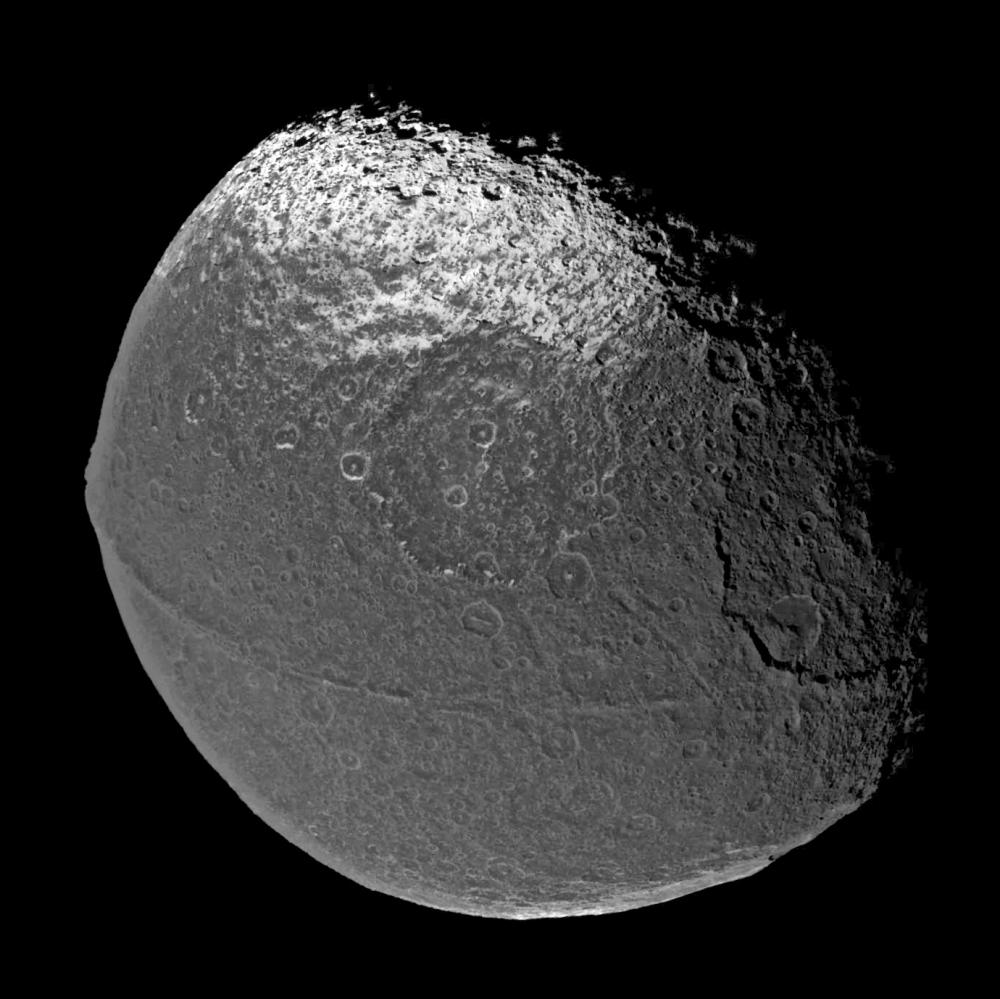
That's Saturn's moon Iapetus. I did a thread about it already, talking about the ridge:
Strange Moons: Iapetus....A Walnut In Space
eriktheawful
I believe you are talking about this picture:
That's Saturn's moon Iapetus. I did a thread about it already, talking about the ridge:
Wow! Just wow....
reply to post by eriktheawful
The strange moon appears to be pitted by numerous lightening-bolt strikes and arcing as if a giant arc welder's device was held close to the moon's surface. The pitting looks like the pitting of our moon . Could both the moon and this strange moon be hollow?
The strange moon appears to be pitted by numerous lightening-bolt strikes and arcing as if a giant arc welder's device was held close to the moon's surface. The pitting looks like the pitting of our moon . Could both the moon and this strange moon be hollow?
siluriancryptic
reply to post by eriktheawful
The strange moon appears to be pitted by numerous lightening-bolt strikes and arcing as if a giant arc welder's device was held close to the moon's surface. The pitting looks like the pitting of our moon . Could both the moon and this strange moon be hollow?
Hollow inside, as in the outer part we see is just a rocky shell with large chambers or a single large chamber inside?
I doubt it seriously based up on the physics involved:
We know our moon has a mass of 7.3477 × 10^22 kg (or 73,477,000,000,000,000,000,000 kg) and a density of 3.3464 g/cm^3 (which is an average density of many types of rocks).
We are able to tell this based upon some other things: the size of the moon, and it's gravity.
When we have space craft flyby or orbit another body in space, the way the space craft behaves shows us how that object's gravity is affecting it. This in turn allows us to figure out an object's mass much more accurately because any object with mass has gravitation, and the more mass it has, the more gravitation it has.
A very good example of how this helps us is when Voyager 2 flew by Neptune. For a very long time, Neptune's mass was something hard for us to figure out. However, the effect it's gravity had on Voyager 2 as it flew by Neptune allowed us to calculate Neptune's mass with a high degree of accuracy.
It works the same for Mimas as Cassini has flown by it and we are able to measure the effect it's gravity had on the Cassini probe, and of course all the different space craft that we have had fly to the moon and especially those that have orbited it.
Another way to infer an object's mass, is by knowing it's density and size. An object that is filled with air is going to be less dense than a solid object. The denser it is, the more mass it has.
You can observe this using a 2 liter bottle of soda. A 2 liter bottle of soda is filled with a liquid that consists mostly of water, ingredients like sugar and coloring that has a density just a little bit more than water. Then the plastic of the bottle itself also has a specific density. Measuring the bottle gives us it's size and of course it's volume.
Now pour out all the soda from the bottle. It's density is now drastically different as the bottle is filled with air now and not a more dense material (the liquid soda). You can tell it's mass has changed without even having to measure it simply by how the empty bottle full of air feels in your hand compared to a full bottle.
With our moon (and Mimas) we can measure their size (which also gives us their volume using basic geometry). Spectral analysis of it's surface tells us what they are made of (at least on the surface, since that is the area that is reflecting the sun's light). However what we see and what the spectroanalysis tells us can be highly suggestive of what is below that center.
What helps us know better is that space craft traveling near it. When it flies by it, gravity pulls on the space craft, changing it's course. The amount of pull is known by how much we have to tell the craft to correct it's flight path to compensate for that pull.
Now we are armed with really good information: Size, Volume and Gravitational Strength.
By knowing those 3 things, you can find an object's mass using physics. When you know the object's mass, you can then calculate it's density because knowing the mass of an object, and it's size is going to tell you how dense something is.
Density tells us a lot of what an object is made up of. Objects with densities that are close to 1.0 g/cm^3 tells us there is a LOT of water there because that is the density of water. Having a density of 3.0 g/cm^3 or more tells us the object is made up mostly of rock.
For example, the average density of Earth is 5.515 g/cm^3.
If our moon (or Mimas) were hollow, then their density would be a LOT lower. For example, our air at sea level and 0 deg C has a density of only 0.001293 g/cm^3.
You can physically feel the difference when you walk through the air (least dense), walking through deep water (more dense) and try to walk through a large rock (most dense, and will hurt if you try to do that).
Another example is my 30 gallon fish tank. when it's empty, I can pick it up. When it's full of water, there is no way I can pick it up as it is much to heavy, and if it were full of a denser material than water, say sand, it would be equally impossible for me to pick up or move.
Using a simple equation, F=mg, where F = force measured in Newtons, m = mass of object and g = gravitational acceleration of that object, we can find out what an object's mass is if we know the force and the gravitational acceleration of that object. If we use it for the moon (because we know how space craft act trying to navigate around the moon) we are able to use that formula to find the moon's mass.
Now, if the moons were hollow all those numbers would be different, because the mass of the moons would be a LOT lower, because their density would be a LOT lower. As this makes their mass a LOT lower, then their gravitational attraction would also be a LOT lower.
Having such a low gravitational attraction, we would not get the tides we get here on Earth either.
It IS possible for there to be "voids" inside both our moon and other moons, smaller areas that have no mater in them. But the basic physics for how these moons behave show that they are not hollow.
The math just does not work out for it.
Moons without atmospheres having craters ???? Who'd believe such a thing....
I can't wait for Dawn spaceship to reach Ceres and give us amazing pics
Xtrozero
The impact that ripped the moon from the earth was rather large, most likely so large there would not be a crater so to speak.
What's interesting about the moon in it's orbital position and dimension in relation to the earth and the sun, if the big whack or double big whack theory is to be accepted as the cause of lunar formation, is it's unfathomably coincidental relationship favorable to life and the evolution of life on earth whereby the ancient moon appeared up to 15 times larger in the sky than during the present epoch being that much closer, driving the process of evolution through massive storms and powerful tidal forces by which salt water would flow far far inland, dissolving molecular recombinations/proteins-DNA - unto the present day when the moon perfectly or all but perfectly and from a visible POV, perfectly reflects and eclipses the sun, with the shadow of the earth also perfectly eclipsing the moon, a phenomenon that is more than "mere" coincidence, to the degree that it favors life as an outcome, and which could only be meaningful or significant to an earth-based observer ie: us. while at the same time confounding the strong anthropic principal in that very observation (it's meaningfuyl or significant because we are here to see it). Occam's razor then slices in favor of an intelligent design from a first/last cause in order so that this very experience might be possible like a kingdom shared from before the foundation of the world.
So the big whack theory of lunar formation, if it's to be taken seriously demonstrates a degree of astronomical coincidence in favor of life as we know it that must be considered at THE very farthest edge and point of the probability curve with life being nothing but an "accidental" consequence, or, the moon formed, not randomly, but with super high precision astro-engineering of some kind by some creative agency or UCA (unknown creative agency) even from a first/last cause, drawing only just the right amount of earth mantle material from the proto-earth, and no more, so as to find the precise orbit by which the earth would sustain for the long haul of evolutionary development, it's precise tilt on it's axis and the wobble by which the tides and trade winds and the weather would be regulated, to the cycle of life itself including the human reproduction cycle - yet done in such a way that we would be given to see it and recognize it, not as mere coincidence and meaningless purposeless nonsense, but something made, intentionally, with us in mind, even from the very get go.
The moon is the midnight sun. And as the moon is to the sun, by reflection, so to does the son of man and son of God reflect the image of the first father as a crown jewel in the creation (included, intentionally).
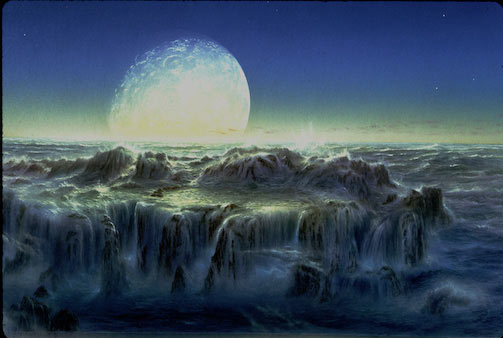
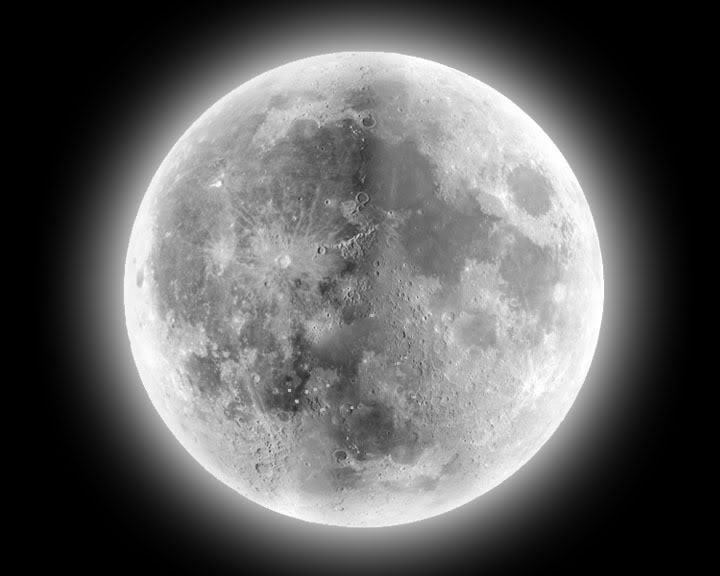
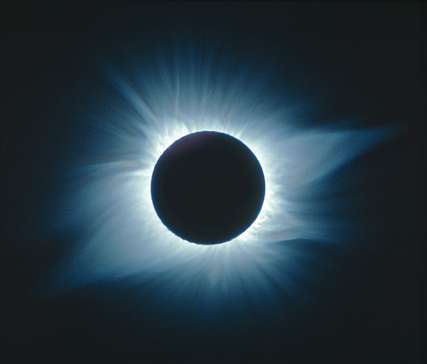
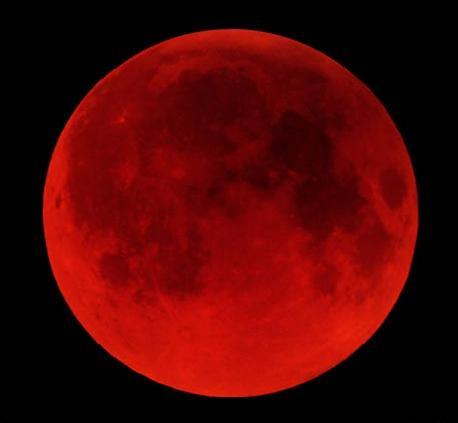
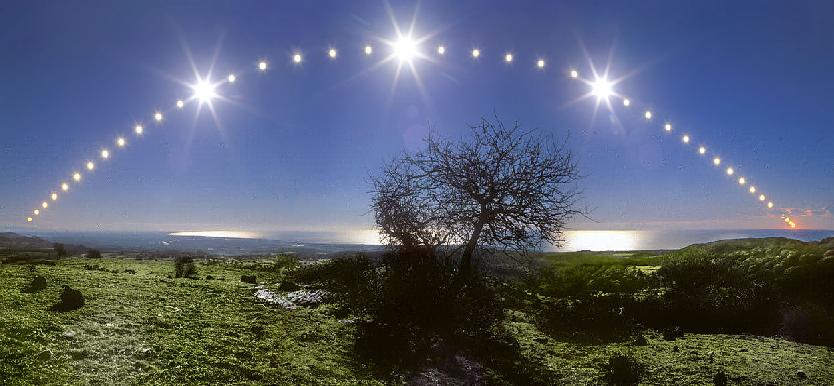
No sane or reasonable person can take it for granted.
Deny ignorance!
Best Regards,
NAM
edit on 22-9-2013 by NewAgeMan because: (no reason given)
reply to post by NewAgeMan
Having spent half of my growing up life in many different countries that I lived in, exposed to a large variety of peoples, cultures and religions, I have the utmost respect for other people's beliefs.
With that said, please refrain from turning my thread (which is about Saturn's moon Mimas) into a Intelligent Design vs. Natural Solar Formation. That's off topic, and there is already a very good forum dedicated here on ATS for those types of debates.
Thanks ahead of time.
Having spent half of my growing up life in many different countries that I lived in, exposed to a large variety of peoples, cultures and religions, I have the utmost respect for other people's beliefs.
With that said, please refrain from turning my thread (which is about Saturn's moon Mimas) into a Intelligent Design vs. Natural Solar Formation. That's off topic, and there is already a very good forum dedicated here on ATS for those types of debates.
Thanks ahead of time.
reply to post by eriktheawful
Sorry, just wanted to put it out there for consideration that's all because it's so astonishing and trippy when thoroughly examined, but you're right that it's off topic, although we were talking about a variety of moons around different planets and earth's moon needn't be excluded from a moon discussion. Nevertheless I apologize, defer and digress. Best regards, NAM.
Sorry, just wanted to put it out there for consideration that's all because it's so astonishing and trippy when thoroughly examined, but you're right that it's off topic, although we were talking about a variety of moons around different planets and earth's moon needn't be excluded from a moon discussion. Nevertheless I apologize, defer and digress. Best regards, NAM.
reply to post by eriktheawful
Thank you ond and all, especially OP, highly educational, more info than found on a NASA brief report, and plenty to give a wider reason to think again.
Thank you ond and all, especially OP, highly educational, more info than found on a NASA brief report, and plenty to give a wider reason to think again.
NewAgeMan
reply to post by eriktheawful
Sorry, just wanted to put it out there for consideration that's all because it's so astonishing and trippy when thoroughly examined, but you're right that it's off topic, although we were talking about a variety of moons around different planets and earth's moon needn't be excluded from a moon discussion. Nevertheless I apologize, defer and digress. Best regards, NAM.
No problem.
Maybe I'll add our moon to a Strange Moons thread that I do in the future. Next up is either going to be Io or Triton. Not sure yet.
Justoneman
LadyGreenEyes
reply to post by eriktheawful
Iapetus is the one that has fascinated me for some time now. Talk about a "death star" moon! I saw one picture, with the light around it, that showed flat edges. You can see it here - NASA link
...and here is the picture -
Strange moon, that one.
Now that photo begs the question, just how did it glow like that when the other moons around Saturn have the same background light and DONT glow?
I have no idea. The whole thing is weird. The site where I first read about it, the guy goes a bit too far, I think, in his guesses, but the moon is definitely weird.
eriktheawful
LadyGreenEyes
reply to post by eriktheawful
Iapetus is the one that has fascinated me for some time now. Talk about a "death star" moon! I saw one picture, with the light around it, that showed flat edges. You can see it here - NASA link
...and here is the picture -
Strange moon, that one.
My last thread was about Iapetus:
Strange Moons: Iapetus......Walnut In Space
I will check that one out! We do have a lot of weirdness in the solar system, eh?
Thought I'd plop my recent image of Mimas (seen at the top of Saturn's rings) here:

Created from raw images taken through red, green, and blue filters on 18 Jan 2005 using narrow angle camera.
Inspired by the "Mimas Blues" article at www.nasa.gov...
Credit: NASA/JPL/Space Science Institute/M. Kakitsev
The small moon near the thin F ring is Pandora, I think.

Created from raw images taken through red, green, and blue filters on 18 Jan 2005 using narrow angle camera.
Inspired by the "Mimas Blues" article at www.nasa.gov...
Credit: NASA/JPL/Space Science Institute/M. Kakitsev
The small moon near the thin F ring is Pandora, I think.
new topics
-
Trudeau Resigns! Breaking
Other Current Events: 1 hours ago -
Live updates: Congress meets to certify Trump's presidential election victory
US Political Madness: 2 hours ago -
Gravitic Propulsion--What IF the US and China Really Have it?
General Conspiracies: 2 hours ago -
Greatest thing you ever got, or bought?
General Chit Chat: 3 hours ago
top topics
-
Sorry to disappoint you but...
US Political Madness: 17 hours ago, 17 flags -
Trudeau Resigns! Breaking
Other Current Events: 1 hours ago, 13 flags -
OK this is sad but very strange stuff
Paranormal Studies: 14 hours ago, 9 flags -
Live updates: Congress meets to certify Trump's presidential election victory
US Political Madness: 2 hours ago, 7 flags -
Islam And A Book Of Lies
Religion, Faith, And Theology: 15 hours ago, 6 flags -
Gravitic Propulsion--What IF the US and China Really Have it?
General Conspiracies: 2 hours ago, 5 flags -
Greatest thing you ever got, or bought?
General Chit Chat: 3 hours ago, 3 flags
active topics
-
Trudeau Resigns! Breaking
Other Current Events • 33 • : Flyingclaydisk -
Winter Storm
Fragile Earth • 42 • : Oldcarpy2 -
OK this is sad but very strange stuff
Paranormal Studies • 5 • : Ravenwatcher -
Musk calls on King Charles III to dissolve Parliament over Oldham sex grooming gangs
Mainstream News • 188 • : Oldcarpy2 -
Joe Biden gives the USA's Highest Civilian Honor Award to Hillary Clinton and George Soros.
US Political Madness • 54 • : mysterioustranger -
Greatest thing you ever got, or bought?
General Chit Chat • 9 • : mysterioustranger -
Speaking of Pandemics
General Conspiracies • 10 • : mysterioustranger -
-@TH3WH17ERABB17- -Q- ---TIME TO SHOW THE WORLD--- -Part- --44--
Dissecting Disinformation • 3948 • : Thoughtful3 -
Petition Calling for General Election at 564,016 and rising Fast
Political Issues • 223 • : gortex -
Gravitic Propulsion--What IF the US and China Really Have it?
General Conspiracies • 4 • : Boomer1947

